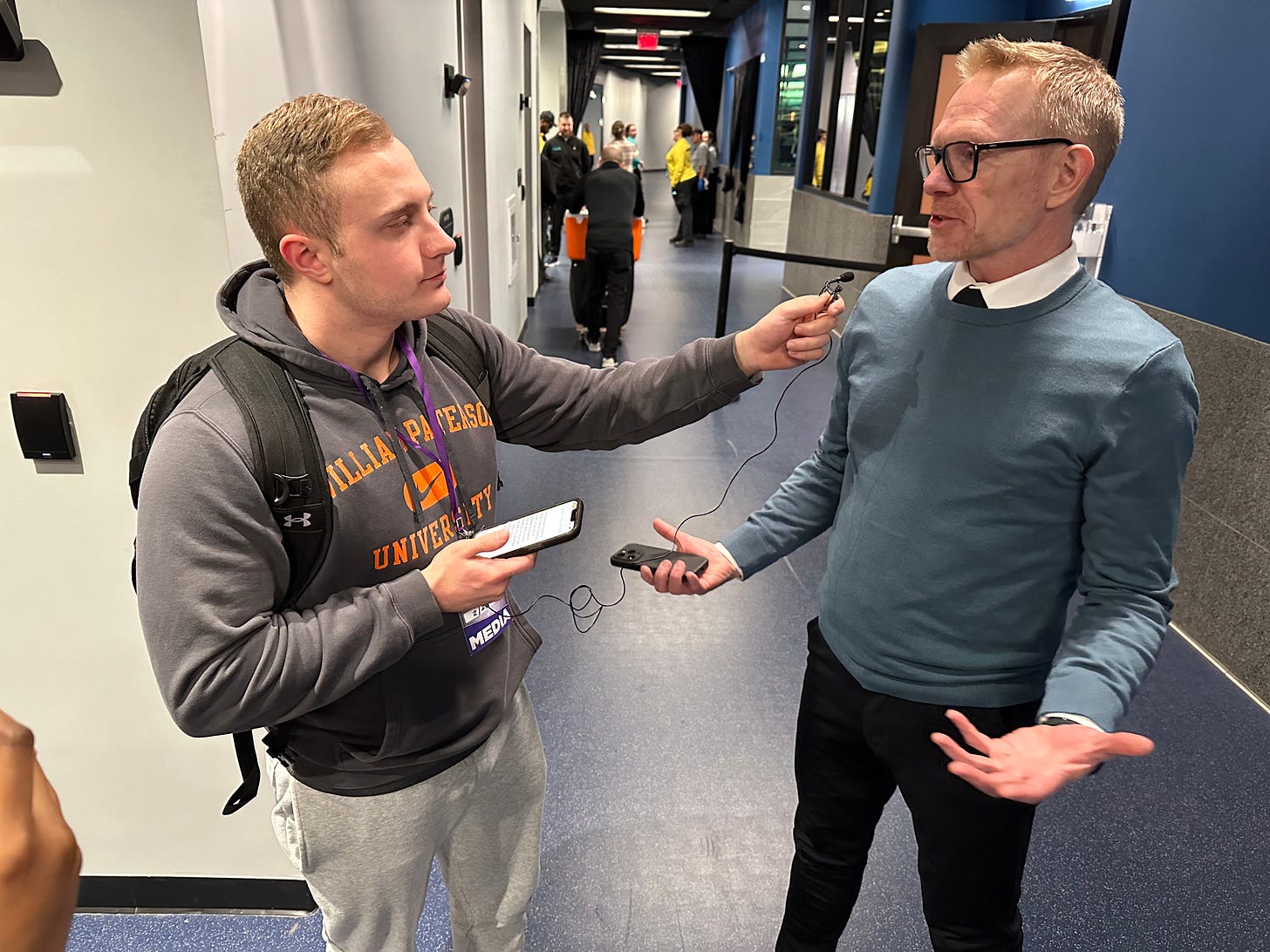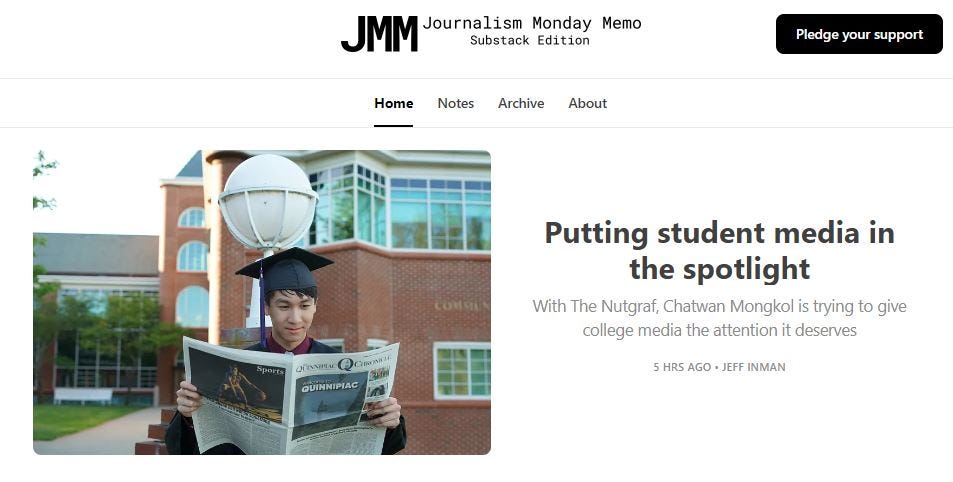'It’s a shame' a New Jersey college doesn't have a newspaper
But The Beacon is on its way back. Plus, how students engage with media pros

When Thomas Sherwood arrived at William Paterson University looking to report and write, he contacted the campus newspaper — but never heard back.
That was because The Beacon was shuttered due to declining participation and funding, a challenge that mirrors struggles seen in student media at minority-serving institutions.
Sherwood thought to himself: Something needed to be done.
“It’s a shame that we don’t have a newspaper and a place to show how we can write,” Sherwood said. “I want to make sure that the people after me and the people with me right now get to do that.”
Now a sophomore, Sherwood is doing that “something”: Trying to revive the nearly century-old publication on top of being an executive producer for a podcast that features media pros alongside his peers and advisor, Nick Hirshon.
Partnering with the ReNews Project, Hirshon said the goal is to recruit a full staff for The Beacon by the semester’s end and resume regular publication by fall.
Hirshon, an associate professor of journalism, came to the New Jersey school in 2016 when the newspaper was still active and saw the challenges firsthand.
Many students at William Paterson came from economically disadvantaged backgrounds, juggling multiple jobs to make ends meet.
About 67% of students there received some form of financial aid, with 47% on federal Pell grants, according to data from the U.S. Department of Education. Students of color make up 60% of the population.
“Student journalism takes time and that’s a resource a lot of these students just don’t have,” Hirshon said.
Wesley Wright, who heads the ReNews Project, has been working to start and revive newspapers at historically Black colleges and universities and Hispanic-serving institutions including Spelman College and Coppin State University.
These schools often find themselves in news deserts without a competitive pathway for aspiring journalists to train, as The Nutgraf previously reported.
The help, nearly $10,000 worth of services and goods, includes free racks for distribution, a one-year subscription to a content management system and memberships to professional associations for staffers and advisors.
Wright pointed to another problem: branding. He said because of turnover at a college, not having a newspaper for a few years can seem like “an eternity.”
That’s why Sherwood, The Beacon’s editor-in-chief, thought it was important to bring it back. He said, “It’s just the legacy of it.”
Sherwood envisioned a digital news site featuring multimedia projects like podcasts and videos. Wright said he hoped the paper could publish at least seven stories a week.
Hirshon, on the other hand, stressed the importance of student journalism, particularly in the context of declining local news and the absence of a local government watchdog.
He sees The Beacon as a platform for students to voice their “annoyances” such as parking issues and high tuition.
Despite hurdles, progress is evident.
Before the ReNews Project got on board, The Beacon didn’t even have a website due to lack of payment. Students were locked out of social media accounts.
The group got those back.
Engagement efforts with alumni are underway. Several students already expressed interest in contributing, according to Wright.
“It’s been a major part of our community for a long time and it deserves to be supported,” Hirshon said.
Asked about a financial mechanism built in to support The Beacon staffers, Hirshon said he’s not aware of any, but noted the availability of donor scholarships and recent university donations aimed at bolstering student journalism.
‘Surrounded by so many smart journalists’
In addition to The Beacon, William Paterson boasts other media outlets including a TV station, a radio station and a podcast produced by the Society of Professional Journalists chapter on campus.
This podcast, recognized nationally, features a weekly interview with professional journalists from big-name networks such as CBS and ESPN.
As an economically disadvantaged campus, Hirshon said he wanted to bring this experience to as large a community as possible, and he thought podcasts could achieve that.
Students would tell Hirshon which journalists they want to hear from. He would then reach out to his contacts or go on LinkedIn to find a friend of a friend to reach those people.
“Journalists tend to be pretty down to Earth and available,” he said.
While Hirshon advises and produces most of the podcast episodes, students are involved too.
Sherwood, the executive producer, said he manages things and assigns different tasks including recording, interviewing and writing scripts.
Here are some things Sherwood said he has learned: Working under deadlines, making decisions about whether to run a story, reporting skills and management.
“My goal is creating that campus atmosphere where they’re not just talking about journalism in their course, but they’re constantly thinking about it,” Hirshon said. He hopes “they're being surrounded by so many smart journalists and learning so much that it's inspiring to them.”
WPSPJ is hosting a celebration to recognize its selection as SPJ’s national campus chapter of the year Tuesday, April 16, from 7-10 p.m. High school teachers and college professors are encouraged to bring their students. Register and read more here.
Extra! Extra!
I spoke to Jeff Inmann’s Journalism Monday Memo about why I started The Nutgraf and what I have learned from it. Give it a read!
A blurb from the article: “Chatwan Mongkol must be easily bored. The former New Haven Register reporter couldn’t seem to find enough to do while working on his master’s in media management at New York’s New School. He’d spent his first year out of college covering higher ed in New Haven, home to five universities including Yale. That kept him on his toes. Classes: Not so much.”
Story Spotlight:
How student and professional journalists are rewriting the industry pipeline (Objective Journalism): While professional journalists often recommend that college journalists join their university’s flagship newspapers to gain valuable experience, this commonly touted industry pipeline often isn’t accessible to the voices the industry is missing most.
Featured Opportunities:
The Press Club of Long Island is hosting a webinar on AI in newsrooms April 11.
The CalMatters College Journalism Network is hiring fellows for our 2024-2025 cohort. Applications are due April 12.
As part of SPJ’s ethics week, it’s hosting a webinar on “Just the Facts: How to Find Your Way in a Media Ecosystem Full of Misinformation” April 15.
If you’re between 10-14, apply to this Scholastic Kids Press program.
Applications are open for the High School Journalism Institute for student journalists in Oregon and southwest Washington.
Business Insider is looking for an editorial assistant fellow for the summer. Apply before April 15.
Slate is looking for an editorial intern for its news and politics section. The deadline is May 1, and the role can be remote.
FIRE’s inaugural FIRE Free Speech Leadership Summit for high schoolers in Philadelphia takes place June 23-29, featuring talks on free speech law and journalism. Register now for free.









